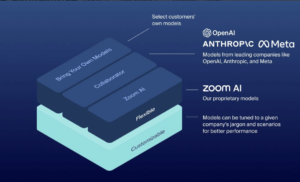 Last week Zoom Video Communications Inc convened Zoom Perspectives, its annual analysts’ summit. During two-plus days of discussions, top executives shared insights technology trends, competitive factors and market dynamics shaping its current and future service offerings. In his opening remarks, founder Eric Yuan reminded attendees that the company had very modest goals when it started in 2011. “When we started our goals were very small,” he said.” “To be a better videoconferencing service.”
Last week Zoom Video Communications Inc convened Zoom Perspectives, its annual analysts’ summit. During two-plus days of discussions, top executives shared insights technology trends, competitive factors and market dynamics shaping its current and future service offerings. In his opening remarks, founder Eric Yuan reminded attendees that the company had very modest goals when it started in 2011. “When we started our goals were very small,” he said.” “To be a better videoconferencing service.”
That proved to be a winning strategy. Supernormal growth was driven by the ease of setting up remote meetings during Covid lockdowns. Zoom’s core technology delivered high quality video and audio without requiring users to purchase special equipment. Its scheduling resources drove integration with the most popular calendaring and email services. December 2020 Zoom’s platform supported around 350 million meetings every day. In April 2023, over 810 million unique global visitors accessed Zoom.us.
Revenues and retained earnings grew exponentially during the pandemic. In the post-pandemic world, Zoom’s top line growth has flattened as travel bans evaporated, schools and medical offices reopened and businesses, including Zoom itself, require employees to show up “live” in the office for specified period sof time. For many that might mean joining Zoom conferences from their cubicles. When they do so, they are bound to discover truly useful features, functions and utilities that are baked into the Zoom platform courtesy of internal development, timely acquisitions and an ecosystem of dozens of partners with deep integrations into Zoom’s platform.
AI is “Top of Mind”
As “hybrid” work becomes a fact of life, Zoom has determined that profitability and customer loyalty will depend on how well it applies Federated LLMs, Generative AI and vertical knowledge toward transforming its core technology from a conferencing platform to one that, in CFO Kelly Steckelberg’s words, services as “one platform for human connection.” That means support of efficient, results-oriented collaboration among enterprises, their partners and customers. To that end, its most important investments are those being made in the fast-changing world of Large Language Models (LLMs), Generative AI and Contact Center.
Experience taught Zoom’s product managers that more than one foundation model will be necessary to support specific use cases and domains. So its approach, pictured below, employs foundation LLMs from selected partners. The list includes OpenAI, Anthropic (another proprietary model) and Meta’s LLama 2 (Open Source) at this time. Zoom also has its own LLM that enables the platform to be trained with an enterprise’s own conversational data without escaping to the public Internet.

Chief Product Officer Smita Hashim was the first to use the magic word when she said “our AI approach is set on the principles of federation.” The company already had a partnership with OpenAI which when it introduced its smart companion ZoomIQ in March 2023. At that time Zoom demonstrated a number of features designed both to delight employees and to make them more productive and efficient. According to Hashim, there are already “3,000 distinct organizations” using the generative AI features, primarily summarization. But that’s just a starting point. ZoomIQ is a smart companion could provide recaps of videoconference-related chats, extract and categorize discussions to support further meetings, or build virtual whiteboards to support brainstorming. Then, of course, it offers to start composing follow-up messages and emails to share with collaborators to move projects along.
Catching Up With Conversational AI
Zoom customers no longer have to make “false choices” among available foundation models. According to Mahesh Ram, founding CEO of Solvvy (which was acquired by Zoom in 2022), Zoom is constantly testing the output of 3rd party models to determine which works best for a specific use case. Zoom takes responsibility for results and for compensating those vendors. Large enterprise customers are also able to bring their own LLMs into the mix. Over the next three years Opus Research expects enterprises to choose solution providers based on their ability to provide the most convenient and safe way to employ the content of customer and employee conversations to hone their competitive advantages.
In that respect, a feature called “Meeting Catchup” feels like the right application at the right time. Knowing that individuals often join Zoom meetings after they have begun, it is a virtual assistant that can provide a recap of the meeting, along with personal highlights, to bring the laggards up-to-speed with the conversation. The value of such a resource for meeting attendees is readily apparent. But there are applications for such a “catch-up” resource that looks across the persistent chats that arise from a Zoom meeting or the asynchronous messages between contact center agents, subject matter experts and customers that can answer the question “what did I miss?” or highlight “what’s important?” for an individual who joins in the middle.
Zoom’s Federated CX Continuum
Vi Chau, head of product for Zoom Contact Center and Zoom Phone, captured the gist of Zoom’s positioning in the market by saying “continuity of conversation is key.” Zoom CX – the umbrella organization for Zoom Contact Center, Zoom Virtual Agents and Zoom Workforce Management – embodies the continuity by defining how AI is applied to improve personal performance for agents, customers and the subject matter experts brought in to build virtual agents or respond to customer queries. Once again, summarization is the starting point. As with “catch-up” mentioned above, agents can review a summary before they engage with a customer. They can be presented with suggested scripts and, when the conversation is over, a Generative AI resource can provide a list of follow-up tasks.
Another big differentiator is bound to be video. As you think of the rich context provided by understanding facial expression and gestures, the prospects of supporting more empathetic customer care are definitely increased. Zoom has catching up to do. Zoom Contact Center has been in the marketplace for only a year and sales cycles in this domain are notoriously long. Its federated managing and deploying LLMs will play a big part in its acceptance in the marketplace.
Categories: Intelligent Assistants

 NiCE Interactions 2025: Agentic AI, Better Data, and a Whole Lot of Partnership
NiCE Interactions 2025: Agentic AI, Better Data, and a Whole Lot of Partnership  Getting It Right: What AI Agents Actually Mean for Customer Support (Webinar)
Getting It Right: What AI Agents Actually Mean for Customer Support (Webinar)  Beyond the Basics: How AI Is Transforming B2B Sales at TP
Beyond the Basics: How AI Is Transforming B2B Sales at TP  Five9 Launches Agentic CX: Toward AI Agents That Reason and Act
Five9 Launches Agentic CX: Toward AI Agents That Reason and Act